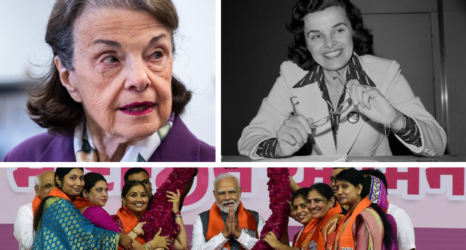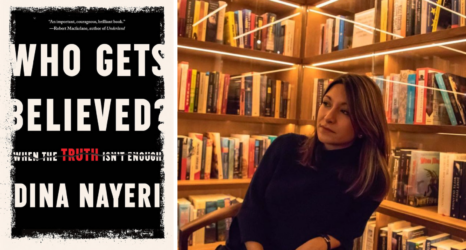President Obama talked about gender equality as a priority of US foreign policy and national security yesterday at the star-powered United State of Women Summit, highlighting steps that his Administration has taken to promote women’s opportunities around the world. But as he acknowledged, the work is far from finished. President Obama may be convinced that gender equality is central to foreign policy, but not everyone else in Washington is on board yet.
In 2011, the Obama Administration released the first National Action Plan on Women, Peace and Security and accompanying Executive Order, becoming the 33rd country in the world to require peace and security policy to incorporate women and gender. The National Action Plan directs the federal government to integrate gender equality throughout the pillars of foreign policy and national security.
The National Action Plan is based on an international commitment to include women and gender perspectives in peace and security. This mandate—UN Security Council Resolution 1325, from 2000—recognized that across regions, countries and cultures, there is one pattern that is just as constant as war: women working for peace. Unfortunately, women peace-builders have been routinely ignored and marginalized in war and peace decisions. Resolution 1325 formally acknowledged the importance of women’s roles in resolving violent conflict for the first time and mandated their full inclusion peace processes.
It took more than a decade for the U.S. government to release a policy to implement this international commitment. It has been an uphill battle to get this on the agenda of the mainstream U.S. foreign policy establishment.
As President Obama indicated in his remarks at yesterday’s Summit, the nexus between gender and security is more apparent than ever. The U.S. is struggling to define an effective policy approach to combat the tidal wave of extremism washing over large swaths of the globe and the intractable conflicts simmering in many countries. The role of women—and their fundamental rights in society—are central to extremist ideologies that are fueling conflict and repression. Whether or not the traditional foreign policy establishment in Washington wants to admit it, gender has been thrust into the center of global security.
The extent to which the Women, Peace and Security vision is realized now hinges on leadership, resources and political will throughout the sprawling U.S. foreign policy apparatus. However, the majority of U.S. policymakers and influencers remain clueless about Women, Peace and Security, and many others continue to question its validity and importance in both overt and subtle ways. If the U.S. is going to champion gender equality globally, the foreign policy community in Washington needs to bring this agenda in from the sidelines.
A feminist foreign policy based on Women, Peace and Security could provide a starting point for tackling urgent and endemic problems of violence and injustice in the world today and could lead to real progress on gender equality around the world. Yesterday, more than 5,000 people yesterday gathered in Washington to support women’s equality. Today, the U.S. could begin to pursue a new vision for foreign policy based on these principles.
It is a tremendous opportunity, but to make it happen, the foreign policy establishment in Washington needs to shift its thinking on several fronts.
Stop asking “why women?”
Women, Peace, and Security is constantly questioned on its merits. “Why women?” “What is the impact of women’s involvement?” “Why does it matter if we include women?” These are all constant refrains in Washington, but the “why women” fixation is misplaced.
Many organizations have already collected persuasive data on the incredible work of women peacebuilders around the globe. The International Civil Society Action Network and Institute for Inclusive Security have documented myriad cases of women’s contributions to peace and stability and valuable guidance for policymakers, and numerous other organizations have also been collecting case studies for years. Academia has been much slower to embrace this area of study, but some universities have established programs to engage in deeper research—including Georgetown University’s Institute for Women, Peace and Security, which now has an online research repository. Valerie Hudson has led rigorous political science research on this topic, demonstrating strong correlations between gender and state security. The Women’s Stats Project, an online database platform, tracks multidisciplinary data on this issue. We should be taking this data and incorporating it systematically into our foreign policy processes.
More data is always needed. But the frequent call for more proof about women’s impact reflects something different than merely intellectual inquiry—it is a double-standard that reveals a deep gender bias and resistance to changing the lens on our foreign policy.
Advocates have been forced to re-frame the message from equality to effectiveness. But should women be excluded from participating in peace processes because they are not effective enough? Is any other group with a stake in war or peace held to the same standard? For women who are putting their lives on the line to press for peace, this is not an analytical exercise. It is a stark choice between life or death, hope or despair, freedom or fear. Meanwhile, there are endless discussions in Washington about proving the case—before anyone is willing to hear what these women have to say or take action to support them.
Isn’t it time to change this conversation on Women, Peace and Security from one of “why?” to one of “how?”
Value the experts
With a U.S. National Action Plan on Women, Peace and Security in place, key government agencies are now responsible for implementation. However, high-level influential roles on Women, Peace and Security in government agencies and think tanks are non-existent. Gender expertise has not been viewed as a strategic leadership skill—in fact, very few leaders have any sense of what it means to use a gender perspective.
Policy leaders could learn from the civil society activists and experts outside of government. But they have rarely reached out in any organized way. The implementation of the U.S. National Action Plan has become a very insular process within the U.S. government. This is a big problem because the Women, Peace and Security agenda is a civil society-led movement, not a government-led movement.
The UN passed Security Council Resolution 1325 because of women’s activism around the world. Governments are critical for carrying it forward, but they can’t represent those who have the best understanding of the nuances in their own communities and countries. Women peace-builders should be given the space to speak and shape the conversation. International civil society organizations can serve as conduits to those individuals and movements on the ground. There should be regular channels for dialogue with civil society to feed into policy strategies, and to monitor progress on the government’s commitments.
Other countries have taken more robust steps to engage with outside experts. The UK’s National Action Plan includes a provision for external monitoring and evaluation specialists to assess progress across the relevant UK government agencies. The Australian National Action Plan explicitly acknowledges the importance of civil society partners, provides that civil society representatives will be included in periodic government working group meetings, and encourages the civil society sector to develop shadow reports. Norway’s National Action Plan establishes a consultative body of government departments and non-governmental organizations to share information.
Without transparency and knowledge sharing, policymakers run the risk of missed opportunities, and worse, pursuing policies that have harmful, unintended consequences. Civil society experts know the landscape. They have seen what works and they know where government interventions can go very wrong.
It is time to treat gender experts in peace and security equally. That will require the Washington establishment to make new space for feminist voices and for Women, Peace and Security leaders to be included in foreign policy dialogue in a deliberate and meaningful way.
Re-think the strategy
While there is increasing discussion about Women, Peace and Security in Washington, there is also widespread confusion about what it means. The Women, Peace and Security agenda is frequently misunderstood as an issue of women’s career advancement in foreign policy careers.
It is a welcome development that women’s under-representation in high-level positions, expert events, and media is finally being discussed in Washington. And the U.S. should be setting an example of gender equality in all interactions with other countries. However, increasing the numbers of women in U.S. senior level policy positions is not a sufficient strategy to support the global struggle for women’s rights.
Gender parity focuses on equal numbers of men and women in organizations and leadership. Gender mainstreaming, on the other hand, is a much more ambitious framework that seeks to integrate gender sensitivity into both internal processes and policy outcomes. This broader strategy should be central to a feminist foreign policy.
The U.S. could take a lesson from Sweden here. Under Margot Wallström’s leadership as the Minister of Foreign Affairs, Sweden has put in place the most far-reaching government effort to pursue a feminist foreign policy. The Swedish Foreign Service Action Plan for Feminist Foreign Policy 2015-2018 lays out a 3 “R” Approach which focuses on promoting human rights, women’s participation and the allocation of resources to make it happen. The plan mandates that the Swedish Foreign Service will “apply a systematic gender perspective” and lays out how this will be done through “the entire breadth of its operations.” In Sweden, there is an understanding that the outward promotion of gender equality in diplomacy goes hand and hand with gender sensitivity in internal policymaking and workforce.
What would a feminist foreign policy in America look like? It would require a two-pronged, holistic approach: advocating for more women in all decision-making processes globally and a deeper inquiry into the gender implications of every single one of our foreign policies and programs.
As a first step, policymakers and influencers need to understand what the Women, Peace and Security agenda really is—and that will require a shift in education and culture. Feminist foreign policy will need to begin at the academic level, where our future policymakers learn the theories and frameworks that guide their thinking and approaches, and extend all the way up the rungs of leadership. We need an honest look at ingrained biases and a willingness to open the closed community of policymakers to include new voices, expertise and analysis on equal footing.
Today, on the eve of another change-over in Washington power, the key question for Women, Peace and Security advocates is this: Will the United States foreign policy establishment embrace an agenda that could transform peace and security for the better, or choose to continue with the status quo—an exclusive club of experts and perspectives that leaves gender on the margins and is inadequate for the global challenges we face?
Women’s rights advocates in the US and in countries around the world are waiting to see what the choice will be.





